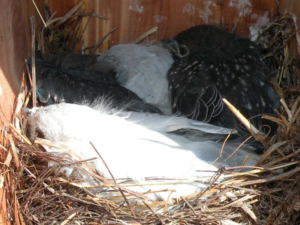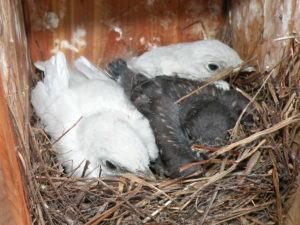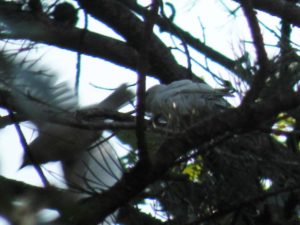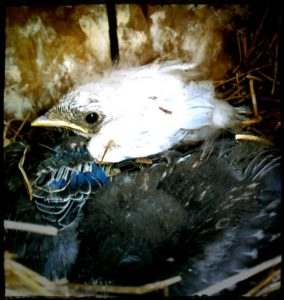In 2010, lightning struck twice when two sets of white (leucistic) bluebirds hatched from the same bluebird box two months apart in Southeastern Pennsylvania. My husband, Ed, had maintained eight bird boxes at that time. Two leucistic birds were found in the first nest and two of them in the second nest (pictured). When I had written about this unique phenomenon, I said it was unlikely to have the privilege of seeing a white bluebird again. Not only was there a second time for this, lightning has struck three times! Another leucistic bluebird has hatched in a bluebird box (100 yds. away from the previous one) at the end of April 2016. Five years later and the leucistic gene is still alive in the area.

Bluebird nest, May 2010
Two leucistic (white) bluebirds, two bluebirds

Second bluebird nest, July 2010. Two leucistic birds and one bluebird
In 2010, Ed contacted radio talk show host, Jack Holcomb from Jack’s Backyard on WEEU and Sialis since they have a vested interest in birds. Both were shocked to read about two nests with leucistic bluebirds.
What exactly is a leucistic bird? Let me first explain what an albino bluebird is. Albinistic birds have a genetic condition much like the leucistic bird. Albino birds have plumage that is white. They don’t have melanin in their bodies which causes them to have pink eyes, pale legs, feet, and beaks. The pink comes from the blood vessels found behind the eyes.
Leucistic birds have melanin which can cause the bird to be lighter in color, white patches where there shouldn’t be any or overall white plumage like an albinistic bird. Leucistic birds have normal colored eyes, feet, legs and beaks. The level of leucism will vary depending on the bird’s genetic mutation.
The white bluebirds in all three nests are leucistic which is still quite uncommon. What makes this so very rare is that these birds were all white except for their eyes, feet, legs and beak. So very rare! Since 2010, Ed has increased the number of bluebird boxes from 8 to 16. Each year he was hoping to see another white bird in one of the boxes and finally his expectations were met. While monitoring the boxes, his attention was drawn to this bird in the back that appeared different. This white bird was tucked in the back with only his tiny head making an appearance.
Some researchers working with birds estimate that true albinism occurs in one out of 1,764 birds. (Source: MDC Online)
Leucistic birds have a low survival rate much like albino birds. No one knows for sure about the survival rate because there are too few of these birds to study. Since they lack protective coloration, they don’t blend in with the other birds. They can have weakened immune systems and vulnerable to predation for the reasons just stated. White plumage reflects heat resulting in heat loss which is necessary during cold, hard winters. White plumage also makes it more difficult to find a mate.
Finding four leucistic bluebirds in 2010 was indeed rare. Having a single white bluebird this year definitely makes this one for the record books! This isn’t something you see or hear about. With two more possible nestings to go this year, anything can happen.
The latest white bluebird is a very rare site indeed!

Two of the 2010 white bluebirds flying around as juveniles
Have a story, please email me at tevangelistaepp@yahoo. Like my tv page at https://www.facebook.com/ACloseUpLookAtAnimalWelfareIssues.



Great photos! Never heard of white bluebirds. Sounds like you have found something special there.
Fascinating
I like Jack Holcomb. I think I heard your husband on his show last week talking about these birds. Was he on then? He sure does know his business about bluebirds. I’ve tried to get them to build a nest at my house but haven’t had any luck. The photo of the flying bird is awesome.
Yes, that was my husband, Ed, on Jack’s show. Thanks!
Cool.
What makes a bird albino vs leucistic? I’ve never heard or seen a white bird except for doves.
pretty bird
Animal welfare began to take place in Western public policy in h-century Great Britain, and since the early of t century, it is a significant focus of interest in science, ethics, and animal welfare organizations. Leucistic is more common than albino. Occurring three times seems a bit rare to me.
Never saw white bluebirds. That’s pretty kool.
What causes them to be white?
We live on a farm in E. NC. This white bluebird came for 5 mornings, much to our delight. Your article is very enlightening.